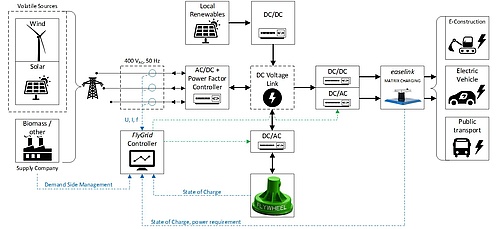
The basis of the innovative battery chemistry for the zinc-air battery is a non-alkaline, aqueous electrolyte.
Credit: WWU – MEET (Judith Kraft)
High-performance, eco-friendly, safe and at the same time cost-effective: the zinc-air battery is an attractive energy storage technology of the future.
Until now, the conventional zinc-air battery has struggled with a high chemical instability, parasitic reactions which rooted in the usage of alkaline electrolytes lead to electrochemical irreversibility. Based on an innovative, non-alkaline, aqueous electrolyte, an international research team led by scientist Dr. Wei Sun of MEET Battery Research Center at the University of Muenster has developed a new battery chemistry for the zinc-air battery which overcomes the previous technical obstacles. The scientific team has published the detailed results of their research project, involving researchers from Fudan University in Shanghai, the University of Science and Technology in Wuhan, the University of Maryland and the US Army Research Laboratory, in the journal “Science”.
Key parameters of the zinc-air battery optimised
“Our innovative, non-alkaline electrolyte brings a previously unknown reversible zinc peroxide (ZnO2)/O2 chemistry into the zinc-air battery”, explains Dr. Wei Sun. Compared with the conventionally strong alkaline electrolytes, the newly developed non-alkaline aqueous electrolyte, which is based on the zinc trifluoromethanesulfonate salt, has several decisive advantages: The zinc anode is used more efficiently with a higher chemical stability and electrochemical reversibility. The full zinc-air batteries thus constructed can long-term operate stably for 320 cycles and 1,600 hours under ambient air atmosphere.
The mechanism of this ZnO2/O2 battery chemistry and the role of the hydrophobic trifluoromethanesulfonate anion were systematically revealed using well-designed electrochemical, analytical techniques and multiscale simulations. The identified increased energy density has now the potential to compete with the lithium-ion battery currently dominating the market. “The zinc-air battery provides a potential alternative battery technology with advantages such as environmental friendliness, high safety and low costs”, emphasises Sun. “This technology still requires further, intensive research and optimisation before its practical application.”
The Latest Updates from Bing News & Google News
Go deeper with Bing News on:
Zinc-air battery
- Batteries News
Drawing Inspiration from Plants: A Metal-Air Paper Battery for Wearable Devices Apr. 3, 2024 — Drawing inspiration from the way plants breathe, a group of researchers has created a paper-based ...
- Zinc-Air Battery Market to Reach $521.1 Million Globally by 2032 at 4.2% CAGR: Allied Market Research
Allied Market Research has recently published a report, titled, "Global Zinc-Air Battery Market Size, Share, Competitive Landscape and ...
- Zinc-Air Battery Market to Reach $521.1 Million Globally by 2032 at 4.2% CAGR: Allied Market Research
Growing demand for clean energy solutions and the rising investments in research and development of zinc-air batteries are anticipated to drive the growth of the global zinc-air battery market ...
- Drawing inspiration from plants: A metal-air paper battery for wearable devices
Jan. 4, 2021 — The zinc-air battery is an attractive energy storage technology of the future. Based on an innovative, non-alkaline, aqueous electrolyte, an international research team has ...
- Scientists make breakthrough with one of the oldest battery storage systems: 'We are initiating a paradigm shift'
Scientists in Germany have developed a lighter, more efficient, and rechargeable zinc-air battery — a tremendous upgrade over current versions, as ChemEurope.com has reported. Zinc-air batteries ...
Go deeper with Google Headlines on:
Zinc-air battery
[google_news title=”” keyword=”zinc-air battery” num_posts=”5″ blurb_length=”0″ show_thumb=”left”]
Go deeper with Bing News on:
Alternative battery technology
- NIO and Lotus announce plans to co-develop unified battery standards, charging, and swaps
Two big names in EVs announced a new strategic cooperation during the 2024 Beijing International Auto Show. Lotus Technology ...
- Batteries News
Drawing Inspiration from Plants: A Metal-Air Paper Battery for Wearable Devices Apr ... and the increasing use of this technology means more lithium is expected to find its way into the ...
- Traton Maintains Battery-Electric Decarbonization Focus
Navistar parent company Traton is standing firm in its belief that battery-electric trucks are the best alternative for trucking fleets looking to decarbonize their operations.
- Assessing suitability of battery storage in hybrid power
If not deployed correctly, energy could be wasted. There are things to consider with battery storage in a hybrid power package: ...
- Advanced Batteries and Sustainability - IDTechEx Experts Discuss Battery Technologies
Battery innovation underpins many sectors, including electric vehicles, sustainability, and renewable energy. In a recent episode of their technology podcast ' Tomorrow's Tech with IDTechEx ', ...
Go deeper with Google Headlines on:
Alternative battery technology
[google_news title=”” keyword=”alternative battery technology” num_posts=”5″ blurb_length=”0″ show_thumb=”left”]










